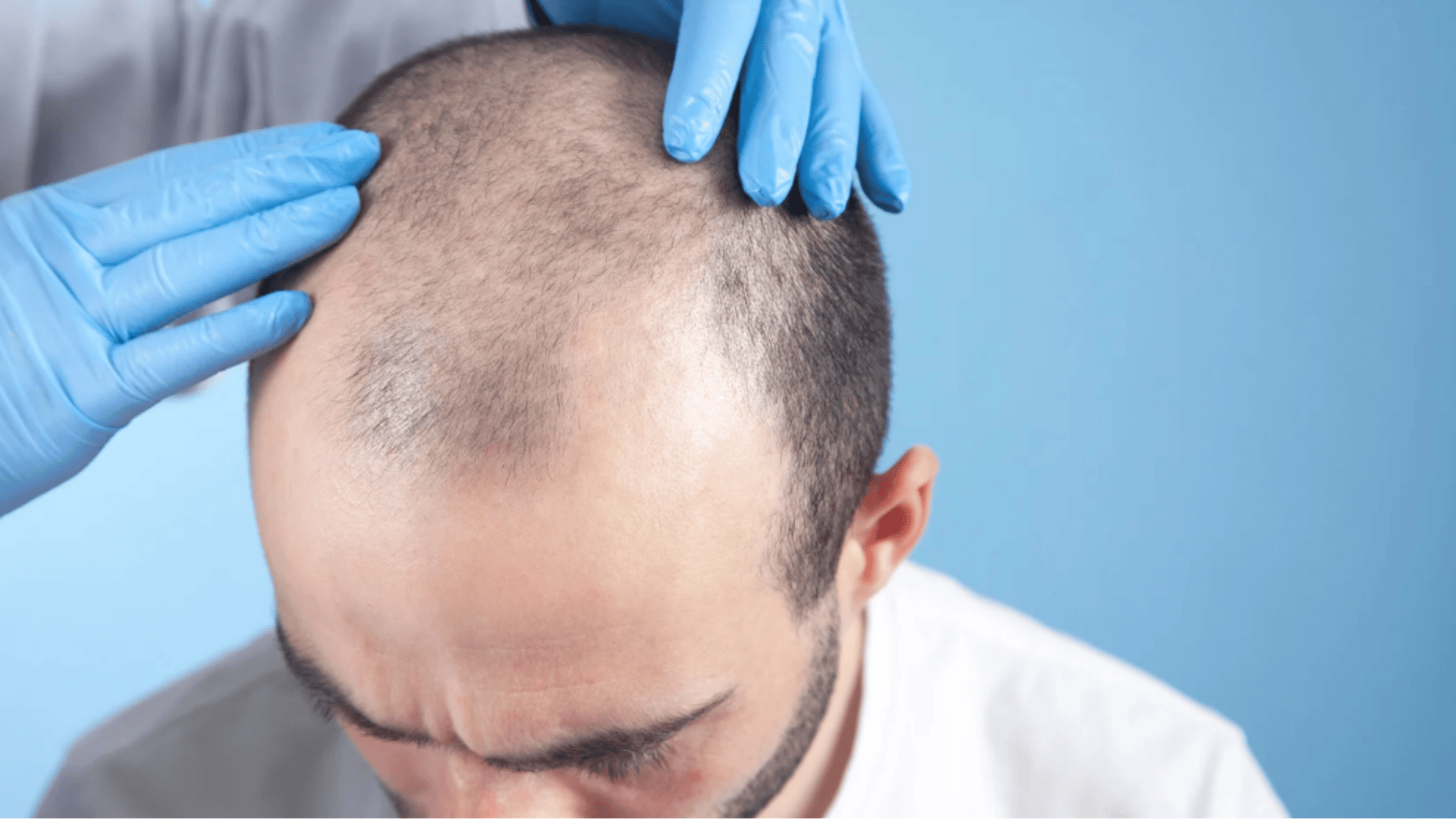Looking for information about scalp cancer but finding conflicting or incomplete details online?
Many people share this challenge, as the scalp is one of the most exposed areas for skin cancer development, yet it is often overlooked.
This blog will walk readers through everything they need to know about scalp cancer, from recognizing early warning signs to understanding treatment options and prevention strategies.
Disclaimer: This blog is meant to provide helpful information, but it’s not a substitute for professional medical advice. If anything unusual appears on your scalp or you have concerns, please consult a healthcare professional promptly.
Why Your Scalp Is at Risk?
The scalp faces unique cancer risks that most people never consider. Unlike other body parts, it gets constant sun exposure through your hair part, yet it’s one of the last places we think to protect.
That hair on your head? It’s not the shield you think it is. UV rays easily penetrate through strands, especially if you have fine or thinning hair, and hit the delicate skin underneath.
The skin on the scalp is often thinner than elsewhere on the body, making it more vulnerable to damage.
Add years of accumulated sun exposure from walking, gardening, or just being outdoors, and you’ve got a recipe for trouble.
Many folks assume their daily baseball cap or occasional hat provides enough coverage, but gaps in protection happen more often than you’d think. Your scalp deserves the same attention you give your face and arms.
Symptoms of Scalp Cancer
Recognizing the symptoms of cancer on the scalp is key to early detection and timely treatment. Many signs can be subtle or mistaken for harmless issues, making awareness essential.
- Non-healing sores: Persistent wounds that crust, reopen, and fail to heal over weeks or months.
- Red, scaly patches: Rough or flaky areas often mistaken for dandruff or dermatitis.
- Painful, bleeding, or itchy spots: Areas that bleed easily, cause discomfort, or feel irritated.
- Changing moles: Alterations in size, shape, or color that may signal scalp skin cancer.
- Unusual lumps: Firm or hard growths under the skin, sometimes tender, possibly a lump on the scalp.
Noticing these warning signs early can make a major difference in outcomes. Any suspicious spot or lump should be checked by a dermatologist without delay.
Know All About the Types of Scalp Cancer
There are several types of cancer that can affect the scalp, each with its unique signs and risks. Knowing the differences helps with faster recognition and early treatment.
1. Basal Cell Carcinoma (BCC)
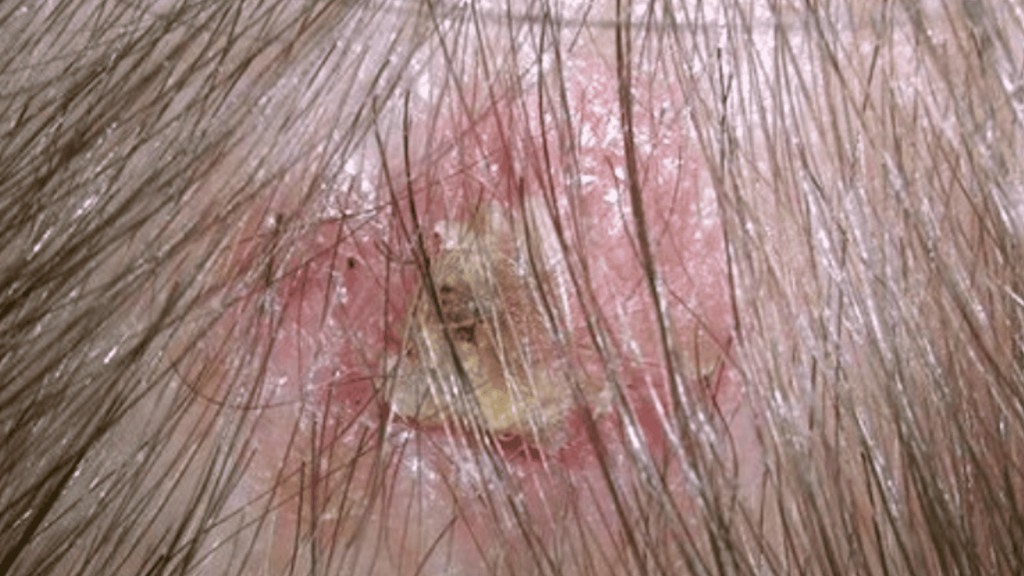
The most common form of scalp cancer typically appears as a pearly bump or a sore that does not heal. It grows slowly and rarely spreads, but still requires timely treatment.
Early detection usually leads to highly successful treatment outcomes, often with minimal scarring.
2. Squamous Cell Carcinoma (SCC)
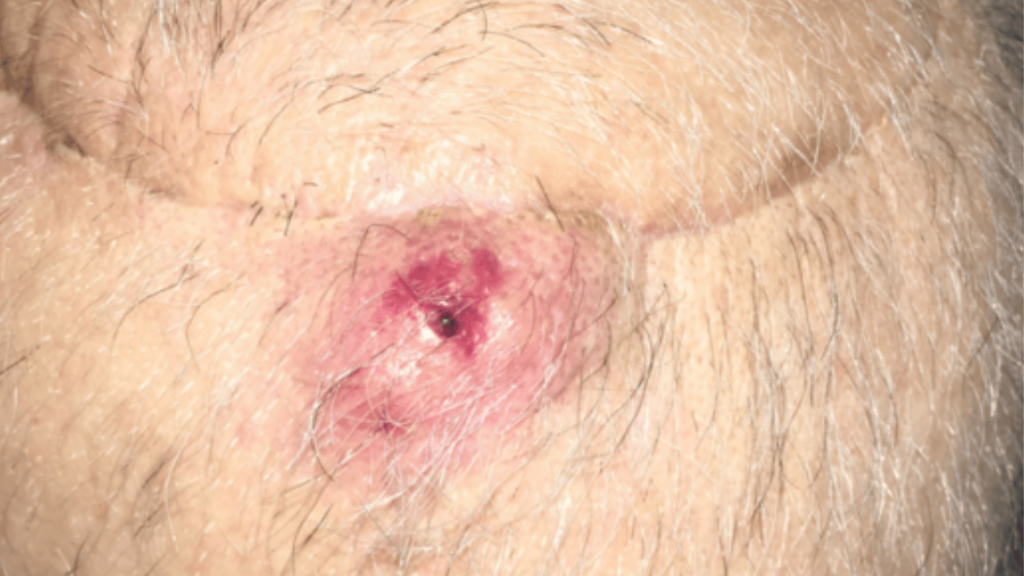
A more aggressive type of scalp cancer, often seen as a firm red nodule or a flat lesion with a scaly surface. If left untreated, it can spread to other areas of the body.
This cancer is linked to long-term sun exposure and may invade deeper layers of the skin more quickly than basal cell carcinoma.
3. Melanoma
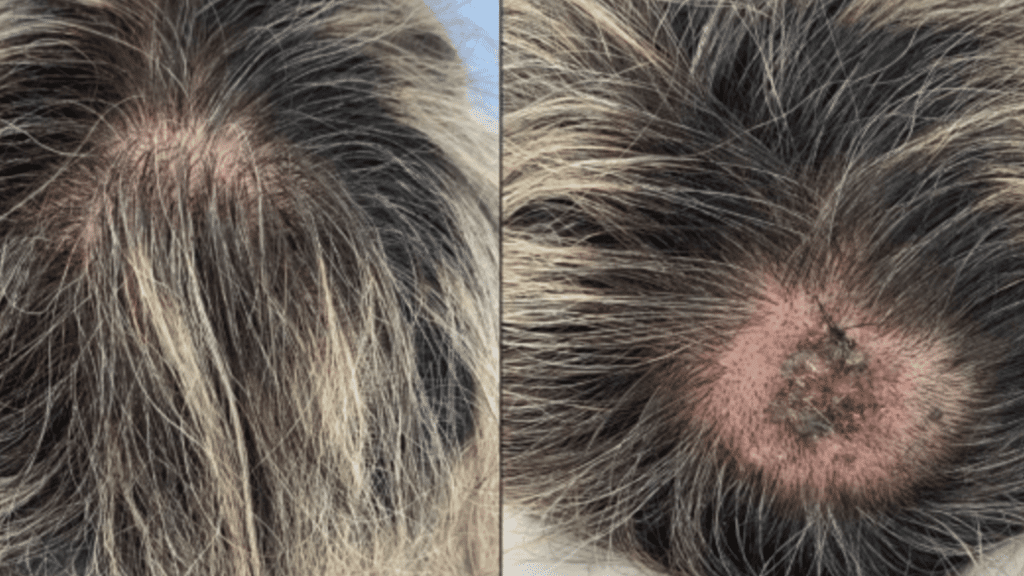
The most serious form of cancer on the scalp often develops as a new dark spot or a mole that changes in shape or color.
A suspicious cancer lump with irregular borders or color variation needs urgent medical attention. Because it can spread rapidly, prompt diagnosis and treatment are critical for survival.
4. The Rare Types
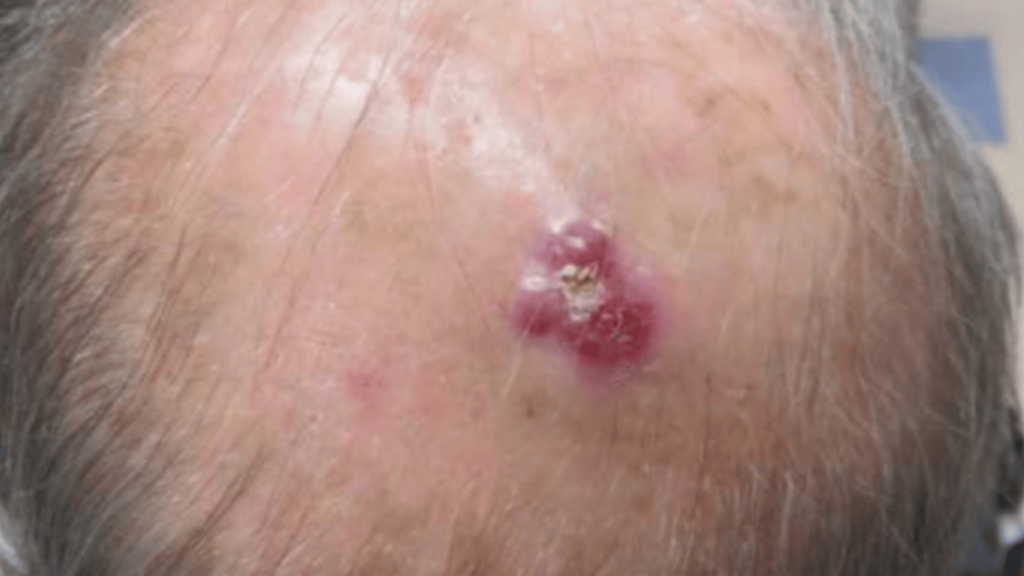
Less common cancers such as Merkel cell carcinoma, sebaceous carcinoma, and cutaneous lymphomas. These are aggressive and demand specialized care and close monitoring.
Though rare, they often require a combination of surgery, radiation, or systemic therapy to manage effectively.
While some forms of scalp cancer grow slowly, others spread quickly and become life-threatening. Identifying any unusual lump on the scalp that may be cancerous early ensures better outcomes and effective care.
Appearance and Identification of a Scalp Cancer
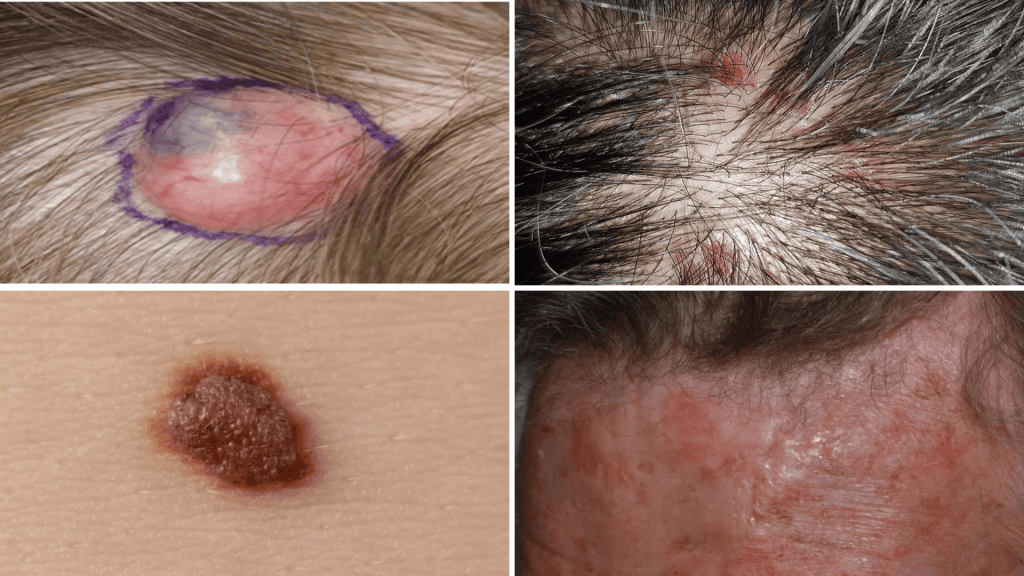
Identifying how a scalp cancer lump appears and recognizing other visual and textural signs helps in detecting cancer on the scalp early, leading to faster diagnosis and treatment.
1. Lumps and Nodules
A lump is one of the more obvious signs of a cancerous growth on the scalp. These are often firm, hard nodules, sometimes raised, and may feel fixed to nearby tissue rather than movable.
They can be flesh-colored, pink, or darker, and may have an uneven surface or growth that develops over several weeks.
2. Persistent Sores or Scabs That Don’t Heal
Scalp sores that repeatedly crust over, bleed, or fail to heal—even when they seem small—should not be ignored.
Unlike minor cuts, these sores may reopen after closing, continue to crust, and last for weeks or months. Persistent or recurring spots on the scalp can be a sign of cancer, making it essential to seek a medical evaluation.
Early attention ensures proper diagnosis and timely treatment.
3. Irregular Pigmentation and Changing Moles
Moles or spots on the scalp that change in color, border shape, or size can be early warning signs of scalp cancer.
Any mole that becomes asymmetrical, develops irregular edges, or shows multiple colors should raise concern. Unlike harmless spots, these changes may indicate the development of cancer on the scalp.
Prompt evaluation by a dermatologist is crucial for accurate diagnosis and effective treatment.
4. Texture, Surface, and Other Features
Rough, scaly, crusted patches; lesions that bleed spontaneously; ulcers; visible blood vessels or waxy/shiny surfaces; even depressed centres or raised edges.
These features help distinguish malignant spots from benign ones.
Self-Check Tip: Patients should part their hair in sections and use their fingertips to feel the scalp monthly. Tracking changes in suspicious areas helps detect scalp cancer early and ensures timely medical evaluation.
Any lump or area on the scalp showing these signs —new bumps, changing moles, or non-healing sores, should be checked by a dermatologist. Early recognition of scalp cancer offers much better outcomes.
Treatment Options for Scalp Cancer
Treatment for cancer on the scalp depends on the type, size, and stage of the tumor. Options range from surgery to advanced therapies, with the goal of removing cancer while protecting healthy tissue.
1. Surgical Treatments
Surgical removal is the most common approach for scalp cancer.
Simple excision removes the tumor along with some surrounding healthy tissue, while Mohs surgery removes cancer layer by layer, preserving as much normal skin as possible.
2. Non-Surgical Treatments
For patients who cannot undergo surgery, non-surgical methods are effective.
Radiation therapy uses high-energy beams to destroy cancer cells, while cryotherapy freezes abnormal tissue with liquid nitrogen. These treatments are most effective for smaller or superficial cancers.
3. Advanced Therapies
Aggressive or metastatic cases may need advanced treatments. Immunotherapy boosts the body’s immune system to fight cancer, while targeted drugs attack proteins that help cancer grow.
These therapies are often used in conjunction with traditional treatments.
4. Recovery and Follow-Up
Recovery requires careful monitoring. Patients should attend regular follow-up appointments to monitor for recurrence.
Healing can take weeks, and proper wound care, along with sun protection, is critical for long-term results. With multiple treatment options available, timely diagnosis makes therapy more effective.
Following medical advice and protecting the scalp after treatment helps lower the risk of future problems.
Lifestyle Tips to Prevent Cancer on the Scalp
Simple lifestyle habits can lower the risk of scalp cancer and support long-term skin health. Prevention is easier and safer than treatment, making protective steps a daily priority.
- Sun protection: Wear wide-brimmed hats or caps outdoors and apply scalp-friendly sunscreen sprays or powders.
- Avoid tanning beds: Artificial UV rays increase the risk of scalp cancer.
- Healthy habits: Maintain a balanced diet, stay active, and refrain from smoking to support a strong immune system.
- Routine checks: Perform monthly scalp self-checks and schedule annual dermatologist exams to detect any unusual cancer lumps early.
- Use protective hairstyles: Styles that cover the scalp, such as scarves or braids, can provide an extra layer of protection.
- Care for existing scalp conditions: Keep dandruff, psoriasis, or chronic irritation under control, as inflamed skin may be more susceptible.
- Routine checks: Perform monthly scalp self-checks and schedule annual dermatologist exams to detect any unusual cancer lumps early.
Consistent prevention and awareness go a long way in reducing risks. Protecting your scalp daily helps you stay ahead of potential problems.
Conclusion
The scalp is often overlooked in regular skincare, yet it remains highly susceptible to sun damage and disease.
Early detection of cancer on the scalp increases treatment success, reduces the need for invasive procedures, and facilitates a quicker recovery.
With consistent sun protection, healthy daily habits, and regular visits to a dermatologist, individuals can lower their risks and identify concerns at an early stage.
Staying aware is the most effective way to prevent and manage scalp cancer.

